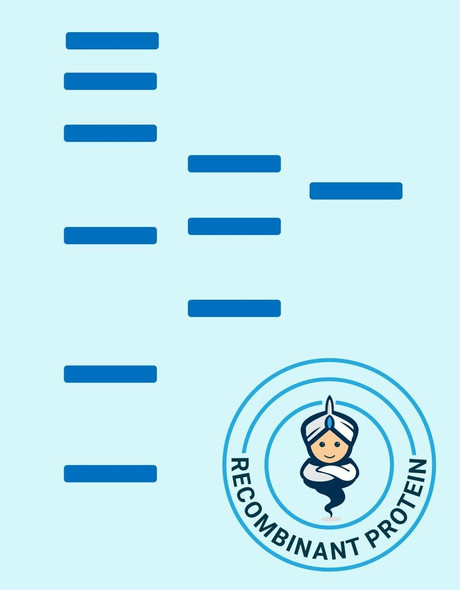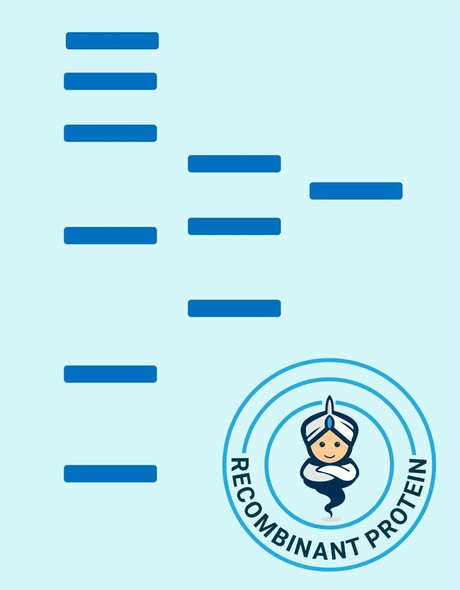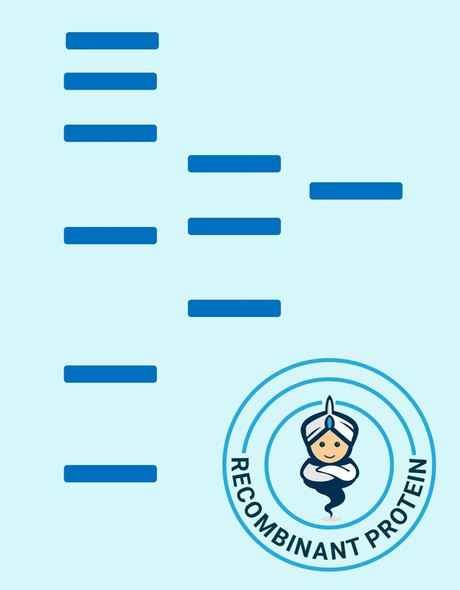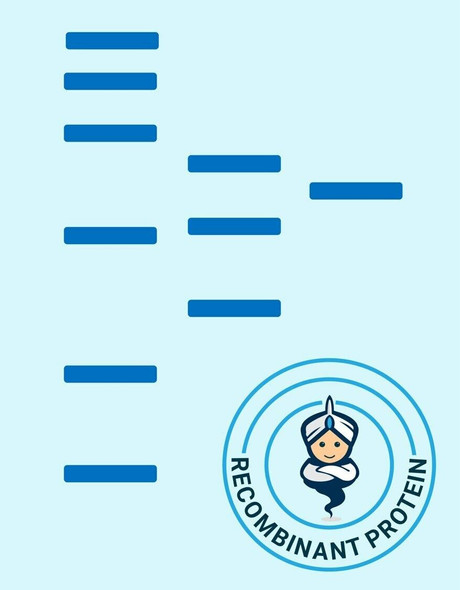Human MCP 2 Recombinant Protein (RPPB1191)
- SKU:
- RPPB1191
- Product type:
- Recombinant Protein
- Size:
- 10ug
- Species:
- Human
- Target:
- MCP 2
- Synonyms:
- Small inducible cytokine A8
- CCL8
- Monocyte chemotactic protein 2
- MCP-2
- Source:
- Escherichia Coli
- Uniprot:
- P80075
Description
| Product Name: | Human MCP 2 Recombinant Protein |
| Product Code: | RPPB1191 |
| Size: | 10µg |
| Species: | Human |
| Target: | MCP 2 |
| Synonyms: | Small inducible cytokine A8, CCL8, Monocyte chemotactic protein 2, MCP-2, Monocyte chemoattractant protein 2, HC14, chemokine (C-C motif) ligand 8, MCP2, SCYA8, SCYA10. |
| Source: | Escherichia Coli |
| Physical Appearance: | Sterile Filtered White lyophilized (freeze-dried) powder. |
| Formulation: | The protein was lyophilized from a concentrated (1mg/ml) sterile solution containing no additives. |
| Solubility: | It is recommended to reconstitute the lyophilized Monocyte Chemotactic Protein-2in sterile 18M?-cm H2O not less than 100µg/ml, which can then be further diluted to other aqueous solutions. |
| Stability: | Lyophilized MCP2 although stable at room temperature for 3 weeks, should be stored desiccated below -18°C. Upon reconstitution CCL8should be stored at 4°C between 2-7 days and for future use below -18°C. For long term storage it is recommended to add a carrier protein (0.1% HSA or BSA).Please prevent freeze-thaw cycles. |
| Purity: | Greater than 95.0% as determined by:(a) Analysis by RP-HPLC.(b) Analysis by SDS-PAGE. |
| Amino Acid Sequence: | The sequence of the first five N-terminal amino acids was determined and was found to be Gln-Pro-Asp-Ser-Val |
| Biological Activity: | The biological activity was determined by measuring the dose dependent mobilization of intracellular calcium (calcium flux) with human THP-1 cells. Significant calcium mobilization is observed with 500ng/mL of recombinant human MCP-2. Human MCP-2 also induces dose dependent chemotaxis of human THP-1 cells with an ED50=30-100 ng/mL corresponding to a Specific Activity of 10,000-33,334IU/mg. |
Chemokine (C-C motif) ligand 8 (CCL8) is a small cytokine belonging to the CC chemokine family that was once called monocyte chemotactic protein-2 (MCP-2). The CCL8 protein is produced as a precursor containing 109 amino acids, which is cleaved to produce mature CCL8 containing 75 amino acids. The gene for CCL8 is encoded by 3 exons and is located within a large cluster of CC chemokines on chromosome 17q11.2 in humans. MCP-2 is chemotactic for and activates a many different immune cells, including mast cells, eosinophils and basophils, (that are implicated in allergic responses), and monocytes, T cells, and NK cells that are involved in the inflammatory response. CCL8 elicits its effects by binding to several different cell surface receptors called chemokine receptors. These receptors include CCR1, CCR2B and CCR5.
Monocyte Chemotactic Protein-2 Human Recombinant produced in E.Coli is a non-glycosylated, Polypeptide chain containing 76 amino acids and having a molecular mass of 8904 Dalton. The MCP2 is purified by proprietary chromatographic techniques.
| UniProt Protein Function: | CCL8: Chemotactic factor that attracts monocytes, lymphocytes, basophils and eosinophils. May play a role in neoplasia and inflammatory host responses. This protein can bind heparin. The processed form MCP-2(6-76) does not show monocyte chemotactic activity, but inhibits the chemotactic effect most predominantly of CCL7, and also of CCL2 and CCL5 and CCL8. Belongs to the intercrine beta (chemokine CC) family. |
| UniProt Protein Details: | Protein type:Secreted; Chemokine; Secreted, signal peptide; Motility/polarity/chemotaxis Chromosomal Location of Human Ortholog: 17q11.2 Cellular Component: extracellular space Molecular Function:heparin binding; chemokine activity; phospholipase activator activity; protein kinase activity Biological Process: positive regulation of catalytic activity; cellular calcium ion homeostasis; exocytosis; cell-cell signaling; calcium ion transport; response to virus; immune response; chemotaxis; inflammatory response; signal transduction; protein amino acid phosphorylation |
| NCBI Summary: | This antimicrobial gene is one of several chemokine genes clustered on the q-arm of chromosome 17. Chemokines form a superfamily of secreted proteins involved in immunoregulatory and inflammatory processes. The superfamily is divided into four subfamilies based on the arrangement of N-terminal cysteine residues of the mature peptide. This chemokine is a member of the CC subfamily which is characterized by two adjacent cysteine residues. This cytokine displays chemotactic activity for monocytes, lymphocytes, basophils and eosinophils. By recruiting leukocytes to sites of inflammation this cytokine may contribute to tumor-associated leukocyte infiltration and to the antiviral state against HIV infection. [provided by RefSeq, Sep 2014] |
| UniProt Code: | P80075 |
| NCBI GenInfo Identifier: | 2506280 |
| NCBI Gene ID: | 6355 |
| NCBI Accession: | P80075.2 |
| UniProt Secondary Accession: | P80075,P78388, A0AV77, |
| UniProt Related Accession: | P80075 |
| Molecular Weight: | 11,246 Da |
| NCBI Full Name: | C-C motif chemokine 8 |
| NCBI Synonym Full Names: | chemokine (C-C motif) ligand 8 |
| NCBI Official Symbol: | CCL8 |
| NCBI Official Synonym Symbols: | HC14; MCP2; MCP-2; SCYA8; SCYA10 |
| NCBI Protein Information: | C-C motif chemokine 8; small-inducible cytokine A8; monocyte chemotactic protein 2; monocyte chemoattractant protein 2; small inducible cytokine subfamily A (Cys-Cys), member 8 (monocyte chemotactic protein 2) |
| UniProt Protein Name: | C-C motif chemokine 8 |
| UniProt Synonym Protein Names: | HC14; Monocyte chemoattractant protein 2; Monocyte chemotactic protein 2; MCP-2; Small-inducible cytokine A8Cleaved into the following chain:MCP-2(6-76) |
| Protein Family: | C-C motif chemokine |
| UniProt Gene Name: | CCL8 |
| UniProt Entry Name: | CCL8_HUMAN |










